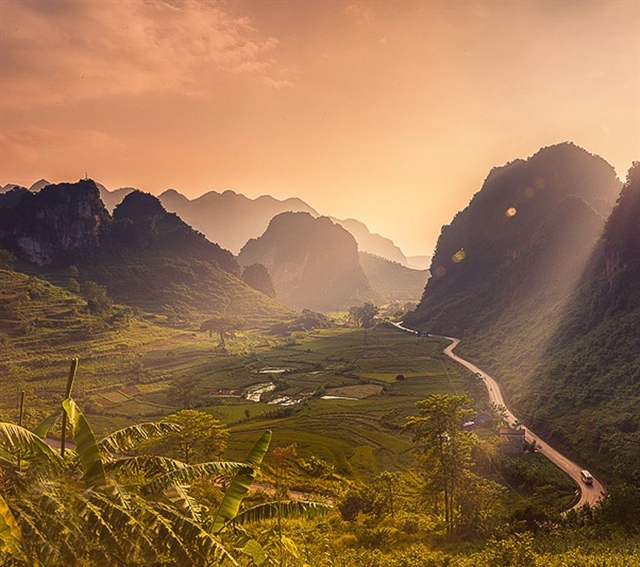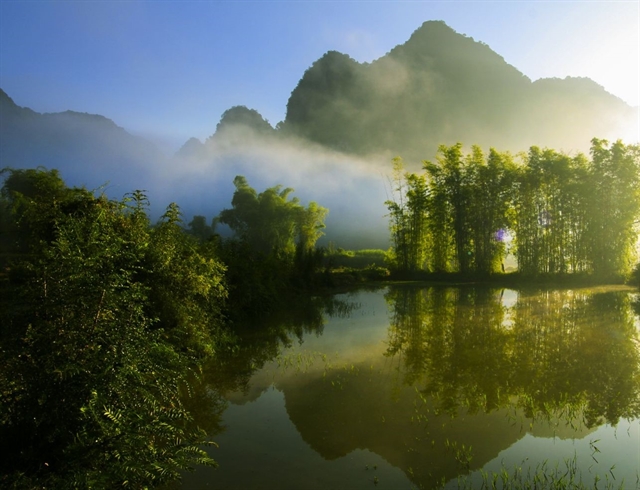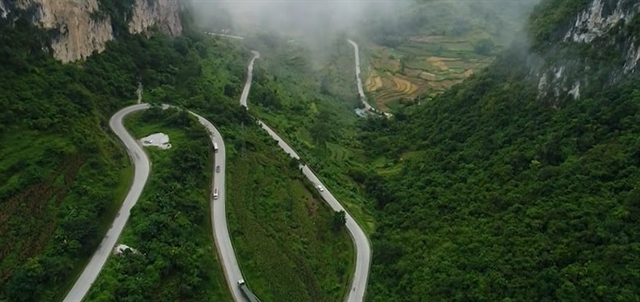The pass is part of Cao Xuyên Hamlet, Quốc Toản Commune, Trà Lĩnh District, Cao Bằng Province. It is the boundary between Hòa An and Trà Lĩnh Districts, located 22km from Cao Bằng City.

The sunset view at Mã Phục Pass. — Photo vietnamtourism.gov.vn
Lâm Giang
Mã Phục Pass is one of the most beautiful passes in the country, located on National Highway 3 in Trà Lĩnh District, Cao Bằng Province, and is a stopover that allows visitors can admire on their journey to conquer the northeast mountains.
The pass is part of Cao Xuyên Hamlet, Quốc Toản Commune. It is the boundary between Hòa An and Trà Lĩnh districts, about 22km from Cao Bằng City.
Mã Phục Pass is 3.5km long and about 700m above sea level, winding between two limestone mountains.
Local legend has it that a mythical hero once rode through this road, and just as he reached the pass, his horse got exhausted and fell prostrate, giving the location its name.
Some others also say the name comes from the two mountains on the sides of the pass. From above, they somehow look like kneeling horses.
The top of the pass is sandwiched between two mountains. This is a unique road, so it has long been considered a "grave" for invading troops when they were ambushed in the pass.
The pass is also one of the most dangerous roads in Việt Nam. However, this is a geological heritage site of Non Nước Cao Bằng Global Geopark recognised by UNESCO.

A lake at the foot of Mã Phục Pass. — Photo reatimes.vn
To conquer the pass, we went through swirling slopes with many twists and turns along the rocky slopes; one side is a mountain, and the other is an abyss.
On this route, we could admire the natural beauty with great views of mountain ranges and valleys full of buckwheat and maize fields. Very beautiful and impressive stone fences surround small houses.
On the top of the mountains in the early morning, clouds appear to bring fanciful beauty. Everything is still wild, and intact, only mountains, forests, trees and friendly ethnic people.
According to research, Mã Phục Pass is a unique geological heritage. About 260 million years ago, there were many active volcanoes under the sea in this area. Experiencing the tectonic process, the pass has many stone blocks stacked of different sizes. It is a testament to the evolution of the earth with other types of blue and white rocks that made us overwhelmed by the beauty of the stones here.

Farm produce sold at the market on the top of Mã Phục Pass. — Photo reatimes.vn
Perhaps, there is no pass as special as Mã Phục, where markets are right on the top of the pass. The market is held once every five days. The ethnic Nùng, Tày and Dao people from remote villages crossed the mountains to carry local goods such as chestnuts, handloom fabrics, knives and hoes to trade for food and other commodities.
Near the pass, there are several famous tourist attractions. We also heard about the Bản Giốc Waterfalls – a magnificent three-layered waterfall that’s an absolute must-visit destination of the province. Mã Phục Pass is on the path from Cao Bằng City to the waterfall, so we could conveniently visit both in one trip.
The waterfalls is in Đầm Thủy Commune, Trùng Khánh District, Cao Bằng Province, on the border with China’s Guangxi Province.

Bản Giốc Waterfalls is a must-visit destination of Cao Bằng. — Photo sgtravel.vn
Bản Giốc is the fourth largest border waterfalls after Iguazu between Brazil and Argentina, Victoria between Zambia and Zimbabwe, and Niagara between Canada and the US. It is considered one of the 10 most spectacular waterfalls in the world.
One of the special features of the waterfalls is the low waterfall part. It does not fall from above but pours into many floors like stairs. That's why it looks like a glowing silk strip between the mountains and forests when viewed from afar. The majestic, poetic waterfalls creates an attractive beauty, making us not want to leave. VNS

Mã Phục Pass is one of the most beautiful passes in the country, located on National Highway 3. — Photo nhandan.vn